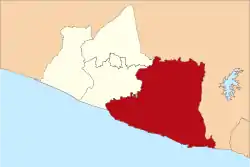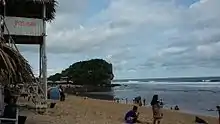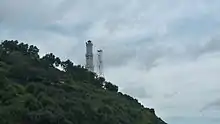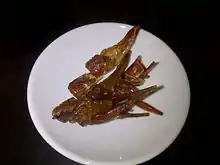Gunung Kidul Regency
Gunungkidul (Javanese: ꧋ ꦒꦸꦤꦸꦁꦏꦶꦢꦸꦭ꧀ ꧉) is a regency area located in the Special Province of the Daerah Istimewa Yogyakarta, Indonesia. The capital city is Wonosari City. The name "Gunungkidul" comes from the Javanese language (mountains in the south of Java Land), whose area is located in the Thousand Mountains range of Java Land South side, Special Province Daerah Istimewa Yogyakarta.
Gunungkidul Regency
Kabupaten Gunungkidul | |
|---|---|
| Gunungkidul Handayani | |
 Seal | |
| Nicknames: Thousands Mount Regency (Kabupaten Pegunungan Sewu), Gathot Regency (Kabupaten Gathot), Thiwul Production Regency (Kabupaten Pembuat Thiwul), River Caves Regency (Kabupaten Sungai Bawah Tanah), Chalk Mount Regency (Kabupaten Gunung Kapur) | |
| Motto: Dhaksinarga Bhumikarta | |
 Gunungkidul Regency in Special Province of Daerah Istimewa Yogyakarta | |
| Country | Indonesia |
| Special Administrative Region | Yogyakarta |
| Capital | Wonosari |
| Government | |
| • Regent | H. Sunaryanta |
| • Vice Regent | Heri Susanto |
| Area | |
| • Total | 1,485.36 km2 (573.50 sq mi) |
| Population (mid 2022 estimate)[1] | |
| • Total | 770,883 |
| • Density | 520/km2 (1,300/sq mi) |
| Time zone | UTC+7 (WIB) |
| Post Code | 55800 |
| Area code | 0274 |
| Vehicle registration | AB |
| Website | gunungkidulkab.go.id |
The Regency covers an area of 1,485.36 km2, about one-third of the provincial area. It had a population of 675,382 at the 2010 Census[2] and 747,161 at the 2020 Census;[3] the official estimate as at mid 2022 was 770,883[1] - comprising 380,635 males and 390,248 females - and so the population density in this regency is relatively low compared to other regencies.
This regency is bordered by Klaten Regency and Sukoharjo Regency in the north and northeast, Wonogiri Regency in the east, the Indian Ocean in the south, and Bantul Regency and Sleman Regency in the west and northwest. Gunungkidul Regency has 18 District (Kapanewon). Most of the district is in the form of hills and limestone mountains, which are part of the Thousand of Mountains. Gunungkidul is known as a barren area and often experiences drought in the dry season, but it has a unique historical feature, in addition to its tourism, cultural and culinary potential.
The traditional snacks and meals from Gunungkidul include "Gathot" and "Thiwul". They are made from Fermentation Cassava and Dry Cassava.
The southern coast of Gunungkidul has several beaches: Baron, Kukup, Krakal, Drini, Sepanjang, Sundak, Siung, Wediombo, Jungwok, Greweng, Sedahan and Sadeng. Some of these beaches provide fresh fish and other sea product supplied by local fisherman. The most notable is Baron Beach. There is a park next to the beach surrounded by seafood restaurants and hostels. There is a fresh fish market on the east side of the beach. On the west side, a river flows out from an almost sea-level cave on the side of the western ridge. The beach itself is khaki-colored and sprawled with traditional fishermen's boats. Beside the main beach, there is a kilometer of white sand beach lying beyond its eastern ridge. It can be reached by a small hike.
Geography
As the name implies, Gunungkidul Regency is dominated by mountains which are the western part of the Sewu Mountains or the South Limestone Mountains (from this nickname, the name "Gunungkidul" is derived), which stretches across the southern part of Java Island starting from the area eastward to Tulungagung Regency.
The Mountains are formed from limestone, indicating that in the past it was a seabed. The findings of ancient marine animal fossils support this assumption. This area began to become land as a result of tectonic and volcanic uplifts since the Miocene.
Gunungkidul Regency is one of the regencies in the Daerah Istimewa Yogyakarta Special Province, with Wonosari as the capital city. The total area of Gunungkidul Regency is 1,485.36 km2 or about 46.63% of the total area of the Special Province of Daerah Istimewa Yogyakarta. The city of Wonosari is located southeast of the Yogyakarta City (the capital of Daerah Istimewa Yogyakarta Special Province), with a distance of ± 39 km. The Gunungkidul Regency area is divided into 18 Districts (Kapanewon) and 144 villages.
Administrative districts



Gunungkidul Regency is divided into eighteen administrative districts (Indonesian: kapanewon), tabulated below with their areas and their populations at the 2010 Census[2] and the 2020 Census,[3] together with the official estimates as at mid 2022.[1] The table also includes the locations of the district administrative centres.
| Name of District (kapanewon) | Area in km2 | Pop'n Census 2010 | Pop'n Census 2020 | Pop'n Estimate mid 2022 | Admin centre |
|---|---|---|---|---|---|
| Panggang | 99.80 | 26,509 | 28,951 | 29,790 | Giriharjo |
| Purwosari | 71.76 | 19,361 | 20,655 | 21,160 | Giritirto |
| Paliyan | 58.07 | 29,083 | 32,017 | 33,000 | Karangduwet |
| Saptosari | 87.83 | 34,270 | 38,323 | 39,620 | Kepek |
| Tepus | 104.91 | 31,889 | 35,251 | 36,360 | Sidoharjo |
| Tanjungsari | 71.63 | 25,698 | 28,178 | 29,020 | Kemiri |
| Rongkop | 83.46 | 26,901 | 28,610 | 29,290 | Semugih |
| Girisubo | 94.57 | 22,188 | 24,490 | 25,250 | Jerukwudel |
| Semanu | 108.39 | 51,737 | 58,155 | 60,180 | Semanu |
| Ponjong | 104.49 | 49,803 | 54,487 | 56,090 | Ponjong |
| Karangmojo | 80.12 | 48,768 | 55,419 | 57,470 | Gedangrejo |
| Wonosari | 75.51 | 78,747 | 87,454 | 90,290 | Kepek |
| Playen | 105.26 | 54,492 | 60,622 | 62,610 | Ngawu |
| Patuk | 72.04 | 30,336 | 34,156 | 35,350 | Patuk |
| Gedangsari | 68.14 | 35,265 | 38,389 | 39,480 | Hargomulyo |
| Nglipar | 73.87 | 29,687 | 32,764 | 33,780 | Nglipar |
| Ngawen | 46.59 | 31,622 | 33,908 | 34,770 | Kampung |
| Semin | 78.92 | 49,026 | 55,332 | 57,300 | Semin |
| Totals | 1,485.36 | 675,382 | 747,161 | 770,883 | Wonosari |
General condition
Geography
Gunungkidul Regency is in a karst region. This leads to difficult geography for farmers and contributes to considerable poverty in the area because of water shortages.[4] Much of the Regency is included in the Mount Sewu (literally "thousand mountains") collection of limestone hills which stretches across parts of southern Java from parts of Kebumen Regency in the west near the border with West Java across to close to the city of Malang in East Java. The Menoreh Hills in the area south of Yogyakarta in Kulonprogo Regency, for example, are part of this series of limestone hills.[5]
Caves
The limestone hills are reported to contain hundreds of caves. These are classified locally as vertical luweng (known as "luweng" in Javanese) and horizontal caves. Jomblang Cave (Luweng Jomblang) and Kalisuci Cave (Luweng Kalisuci) located in the Semanu District in Gunungkidul Regency, as well as other caves in the area, are well-known to local caving (speleological) groups. Some of the caves are quite long; Cerme cave, for example, has an entrance in Bantul Regency and stretches for quite a distance eastward into Panggang subdistrict in Gunungkidul Regency.[5]
Prehistory

From archaeological findings, the area of Gunungkidul Regency is thought to have been inhabited by humans (Homo Sapiens) from 700,000 years ago.[6] Many find the instructions of human existence found in caves and niches in karst of Gunungkidul, especially in Ponjong District. The human propensity Gunung occupy the time it caused most of the lowland in Yogyakarta is still flooded.[7] The arrival of the first humans in Gunungkidul occurred at the end of the Pleistocene period . At that time, the human race Australoid migrated from the Pegunungan Sewu in Pacitan, East Java passing Wonogiri karst valleys, Central Java until it reaches the southern coast of Gunungkidul through ancient, Bengawan Solo.
Borderline
Culture

Gunungkidul Regency is located in the limestone uplands of Java, thus soils are not very good for growing rice. Cassava replaced rice in this area. Some famous Gunungkidul cuisine includes thiwul, gathot (both are cassava-based food), and a delicacy called walang goreng (fried grasshoppers).[8]
Topography
North Zone
The northern zone is called Agung Batur region, with an altitude of 200–700 m above sea level. The situation is hilly, there are sources of groundwater depth of 6m - 12m from the ground. Latosol soil types dominated by volcanic and sedimentary parent hurricane stones. This area includes the districts of Patuk, Gedangsari, Nglipar, Ngawen, Semin, and the northern part of the district of Ponjong.
Central Zone
The Central Zone is called Ledok Wonosari development, with an altitude of 150–200 m above sea level. The soil type is dominated by Mediterranean association with the red and black grumusol limestone. So despite its long dry season, the water particles are still able to survive. There is a river on the land. Groundwater depth ranges between 60–120 m below the ground surface. This area includes the districts of Playen, Wonosari, Karangmojo and Ponjong, and the central and northern parts of Semanu.
South Zone
The Southern Zone is called Pegunungan Sewu development area (Duizon gebergton or Zuider gebergton), with an altitude of 0–300 m above sea level. Constituent bedrock is limestone with characteristic conical hills (Conical limestone) and the karst area. Underground rivers are often found in this region. The southern zone includes the districts of Saptosari, Paliyan, Girisubo, Tanjungsari, Tepus, Rongkop, Purwosari and Panggang, and the southern parts of Ponjong and Semanu.
Climatology
Gunungkidul regency including tropical area, the topography of a region dominated by karst region area. The southern region is dominated by karst region, that are numerous natural caves and underground rivers flowing. Under these conditions cause the condition of the land in the southern area which resulted in less fertile agricultural cultivation in this region is less than optimal. Gunungkidul climatological conditions generally exhibit the following conditions:
- The average rainfall in 2010 amounted to 1954.43 mm/year with the number of rainy days an average of 103 days/year. Wet months 7 months, while the dry months range from 5 months. Gunungkidul north region has the highest rainfall over central and southern regions. Gunungkidul southern region has the most rain beginning late
- Temperatures daily average of 27.7 °C, minimum temperature of 23.2 °C and a maximum temperature of 35 °C.
- Relative humidity ranging between 80% - 85%, not too influenced by the high places, but more influenced by the seasons.
Heirloom
Tombak Kyai Marga Salurung
Tombak Kyai Marga Salurung is one of heirloom gift from the King of Yogyakarta, Hamengkubuwono X on Sunday, May 27, 2001, when the Celebration of 170th Anniversary of Gunungkidul Regency. Spear heirloom that has a new dhapur cekel, warangka kajeng sanakeling symbolize that the district government of Gunungkidul still has a major commitment to achieve lofty ideals are deeply rooted and always siding with the people. The leaders and the people have the attitude or the direction salurung approval, accord, saiyeg - saeka- kapti in the corridors of democracy, which means heavy hands make light work, conscious of their rights, but also respect the rights of others and known for certain obligations.
UNESCO Geopark
Gunungkidul Regency and the nearby Imogiri area (in Bantul Regency) and Pacitan Regency (East Java Province) is being promoted by the Indonesia government to be a UNESCO Geopark, due to their unique and scenic karst landscape. An accessor from UNESCO has visited 4 areas in July 2014. These include:[9]
- Pindul Cave, in tectonic active area, the cave and the Gunungkidul Karst Region give more variation of karst stone/land, if it is compared with Gunung Sewu area in Pacitan and Wonogiri
- Nglanggeran Primeval Volcano
- Gunung Batur Primeval Volcano
- Bobung Tourism Village
- Siung Beach
.jpg.webp)
As a karst region, Gunungkidul Regency has many caves, some of which have underground rivers. At least two of them (Pindul Cave in the Bejiharjo area and Kalisuci Cave in the Semanu area) are regarded as tourist sites[10] where tubing activities can be carried on.[11]
Nglanggeran primeval volcano in the Patuk area is only 600 meters high but there are excellent views from the peak to the north towards Mount Merapi and to the south across to the coast of Java. Scattered giant granite and andesite rock formations called "watu wayang" (puppet rocks) are found at the Mt Nglanggeran area as well as a nearby man-made lake. It takes around 3 hours to hike from the Pendopo Kali Song entrance point to the peak.[12]
Siung Beach Bay is about 300 meters in length, but swimming is prohibited because of dangerous rocks and severe waves. The cliff surrounding the beach, with over 200 tracks, is suitable for rock climbing.[13]
200 meters east of Siung Beach there is a 10-meter Jogan Tide Fall in Tepus district which is 70 kilometers from Yogyakarta in 2 hours drive. Rainy season is the best time to see the Jogan Tide Fall, because in the dry season, the water level is low.[14]
References
- Badan Pusat Statistik, Jakarta, 2023, Kabupaten Gunungkidul Dalam Angka 2023 (Katalog-BPS 1102001.3403)
- Biro Pusat Statistik, Jakarta, 2011.
- Badan Pusat Statistik, Jakarta, 2021.
- Slamet Susanto, 'Ponijo: Sunny disposition keeps water flowing' Archived 2014-12-20 at archive.today, The Jakarta Post, 16 August 2007.
- 'Sewu mountain, a paradise for cave explorers', The Jakarta Post, 30 June 2001.
- Kusuma M. Melacak Manusia Purba Gunungkidul. Kompas daring. Edisi Minggu, 11 Oktober 2009. Diakses 15 Juni 2014
- Kompas - Melacak manusia purba Gunungkidul diakses pada 6 November 2009
- "Walang Goreng Khas Gunungkidul" (in Indonesian). UMKM Jogja. Archived from the original on 6 March 2016. Retrieved 30 March 2015.
- Hari Susmayanti (July 7, 2014). "Kristin Terkejut dengan Keindahan Gua Pindul".
- "Cave Tubing Kalisuci". Retrieved November 11, 2013.
- "Selamat Datang di website resmi desa Wisata Bejiharjo". Retrieved March 24, 2013.
- Diyah Hayu Rahmitasari, 'A piece of heaven on earth', The Jakarta Post, May 13, 2013.
- "Siung, Pantai Indah Bertembok Karang". May 15, 2012.
- "Pantai Jogan, Panorama Air Terjun Di Bibir Pantai". Retrieved August 29, 2014.